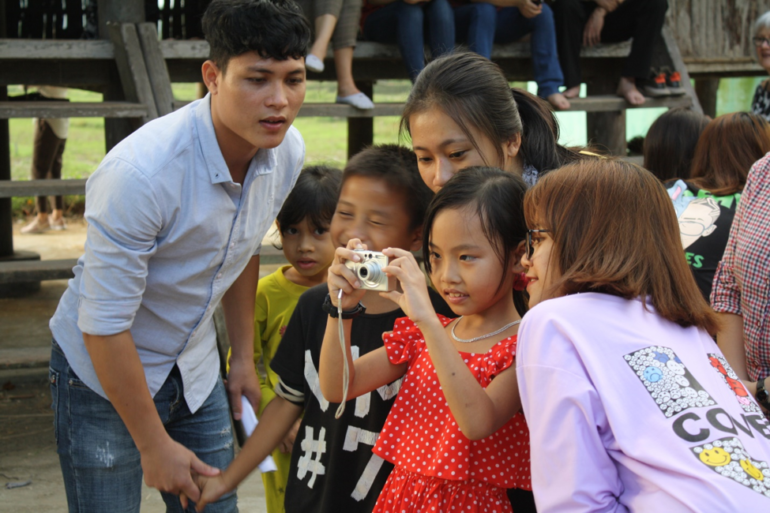How did the students find the photovoice method and dignity in intensive courses

Zơ Râm Anh:
“The photovoice method is quite interesting, but it takes a lot of time to complete it and it can only be applied to individuals, difficult to apply to groups and communities.
The target group is female. In the process of working, we have received a lot of pictures taken by the women themselves. I am most impressed by the picture of the house by a young woman.
According to that woman, that house is her greatest pride. That house is where she was born and raised. No matter where she went, she would always head towards the house, always remembering her home. She said, in that house, her big family lived happily, harmonized, shared with each other from small to large, she never felt dissatisfied or out of pride in everyone in the family. And this is the first time she’s been sharing and opening up about her home.”
Lê Vũ Hoàng Lam:
With the theme “dignity”, we took pictures with children to say what children feel is valuable to them. The photos show the honest view of children and interesting stories about family, friends, homeland… The children were very excited to participate the activities.”
Mai Thị Mơ:
”The mission of the group is to guide the women group in Doi hamlet, Nam Dong village on how to use the camera. Through photos of the people there record that they will tell the story of their daily real life with the topic ‘dignity’. The method of photovoice I found was very interesting and meaningful, but its implementation took quite a long time to get good results.”
Nguyễn Hoàng Sơn:
”I see that there are many problems in the world such as human trafficking, sex slavery, labor slavery, homosexuality, people with disabilities, homeless people, etc., who most of the people do not have a high position in society so they are often constrained to restrain in all aspects, their voice has no weight. From that point on, I think that this method should be replicated to these subjects or more difficult circumstances to help them regain their rights.”
Hồ Thị Đượm:
“I find this course of great significance to me not only to provide a theory but also to have the opportunity to experience, learn some communication skills, teamwork… In addition, I had a chance to meet the locals and learned about some of the Co-Tu customs and cultures.”
Hoàng Đình Văn:
”After the “community development” course, I gained a lot of knowledge about photovoice, especially to experience practicing in the community and better understand the culture and life of Thuong Lo people in general and the community Vietnamese ethnic minorities in particular.”
La Thị Vợt
”However, besides the advantages, there is also a disadvantage because the course with a new approach makes it difficult to do the actual approach directly to the participants. The main activities are to use the camera to take pictures and the photos here have to show the meaning according to the theme given, so when making students difficult to understand how the customers can understand.”
Nguyễn Thị Cẩm:
“I was quite impressed with the story of a local sister who was among the women. She said this was the first time she shared her thoughts with everyone, and it was the first time she talked about her love for her family.
However, one obstacle is that the implementation time is a bit short because the process of working with people needs time to create relationships and through which people will trust and be easier to share.”
Đặng Thảo Nguyên:
”This approach when approaching people is easy to attract because it delves into the lives of each person, bringing them open to people around them and curious to learn about cameras, about technology. The small camera is presented to the people of Doi hamlet as strange things, just seen for the first time. Instructing them to use the camera has to be very patient and well organized, the camera as a means of connecting the project team with people closer and more friendly.”
Phạm Thị Chi:
“Through the method of storytelling by images, sharing about the meaning of the picture, helping people understand themselves, their desires and voice. A picture is simple, but when they share it, they know the meaning and problems.”
Hồ Văn Sơn
”Language is a barrier in the process of communicating and working with foreign teachers, and when working with ethnic minorities, the number of their own language also makes communication and solving like content that is difficult (especially for kids). Some groups have difficulty reaching out to people because they do not have time to meet and work. Besides, the working time to contact people is too short, so it has not helped them to really understand the problem, people are still embarrassed, unable to share all the difficulties and problems they actually encountered (especially women).”
Nguyễn Thị Thu Phương:
“It is very meaningful to work together with people to take photos and share their dignity and to share their thoughts and how they understand dignity, about what they consider to be of great value to their life. This is a method of giving an opportunity for them to speak in a simple way, easy to implement and have specific evidence to enhance the persuasion of the story.”
